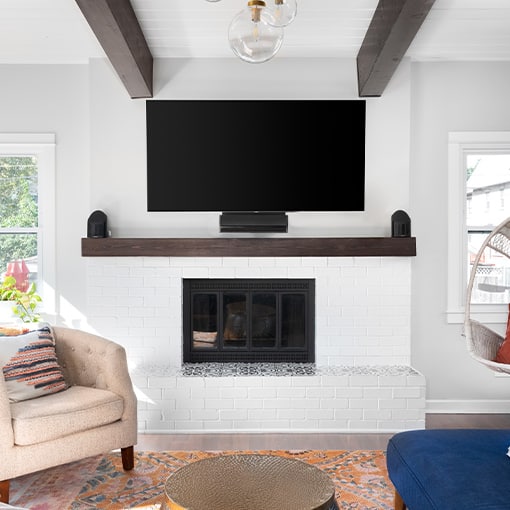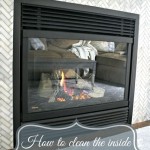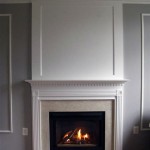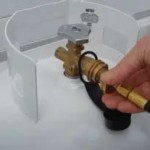Above the Fireplace TV Stand: A Comprehensive Guide
The placement of a television above a fireplace, while aesthetically appealing to some, presents a variety of logistical and design challenges. Addressing these challenges requires a thoughtful approach to ensure both the optimal viewing experience and the protection of electronic equipment. An above the fireplace TV stand, whether a freestanding unit or a customized built-in, serves as a crucial component in achieving this balance. It is important to consider factors such as heat management, viewing angle, cable management, and overall aesthetic harmony when integrating a television above a fireplace.
The integration of technology into living spaces has led to the increasing popularity of placing televisions above fireplaces. This arrangement aims to maximize space utilization and create a focal point within the room. However, without proper planning and implementation using a suitable above the fireplace TV stand, this setup can result in discomfort, potential damage to the television, and an aesthetically displeasing outcome. A carefully chosen or custom-designed TV stand can mitigate these issues and enhance the overall viewing experience.
Heat Management
One of the primary concerns when placing a television above a fireplace is the potential damage caused by heat exposure. Fireplaces, particularly traditional wood-burning models, generate significant amounts of heat that can rise and affect the internal components of a television. Excessive heat can lead to component failure, screen damage, and a shortened lifespan for the device. Therefore, effective heat management is essential when designing and installing an above the fireplace TV stand.
The design of the TV stand should incorporate features that minimize heat exposure to the television. This includes providing adequate ventilation around the television to allow for heat dissipation. Open designs, with ample space between the television and the fireplace opening, are generally preferable to enclosed cabinets. The stand may also incorporate heat shields or deflectors to redirect heat away from the television. Selecting materials that are resistant to heat, such as certain types of metal or treated wood, can further enhance the stand’s ability to withstand elevated temperatures. The use of a mantel can also serve as a heat deflector, redirecting heat outward rather than directly upwards.
Beyond the design of the TV stand itself, the type of fireplace also plays a crucial role in heat management. Gas fireplaces and electric fireplaces generally produce less heat than traditional wood-burning fireplaces, making them more suitable for above-fireplace television placement. If a wood-burning fireplace is the only option, it is crucial to ensure proper fireplace operation and maintenance to minimize heat output. This includes regular chimney cleaning and ensuring proper ventilation to prevent backdrafting of smoke and heat into the room.
Regular monitoring of the television’s temperature is another important aspect of heat management. This can be achieved using temperature sensors or simply by periodically checking the back of the television for excessive heat. If the television feels excessively hot, it may be necessary to adjust the fireplace usage or modify the TV stand to improve ventilation and heat deflection. Consider consulting with a fireplace professional or a home theater specialist to assess the specific heat-related risks associated with the fireplace and television combination.
Optimizing Viewing Angle and Distance
Placing a television above a fireplace often results in a viewing angle that is higher than ideal, potentially leading to neck strain and discomfort during extended viewing sessions. The optimal viewing angle is generally considered to be at or slightly below eye level when seated. When a television is mounted above a fireplace, the viewer is often forced to look upwards, which can cause muscle fatigue and discomfort. Therefore, careful consideration of viewing angle and distance is essential when designing an above the fireplace TV stand.
The height of the fireplace and the distance between the seating area and the television are key factors in determining the appropriate height of the TV stand and the television itself. A general rule of thumb is to position the center of the television screen at eye level when seated. However, this may not always be possible when placing a television above a fireplace. In such cases, it is important to minimize the upward viewing angle as much as possible. This can be achieved by selecting a smaller television screen size or by using a tilting TV mount that allows the viewer to adjust the angle of the screen downwards.
The design of the TV stand can also contribute to optimizing the viewing angle. A lower profile TV stand will position the television closer to the level of the fireplace mantel, reducing the overall height of the installation. Alternatively, a custom-built TV stand can be designed with a recessed area for the television, further lowering its position. Consider the ergonomics of the seating arrangement as well. Reclining chairs or sofas can compensate for a slightly elevated viewing angle, making the viewing experience more comfortable. Experimenting with different seating positions and viewing angles before finalizing the TV stand design can help to identify the optimal configuration.
Beyond the physical positioning of the television and the seating area, other factors can also influence the perceived viewing angle. Room lighting, for example, can affect the visibility of the screen and the viewer’s posture. Adjusting the lighting to minimize glare and reflections can improve the viewing experience. Similarly, the color and texture of the walls surrounding the television can influence the perceived contrast and clarity of the image. Darker walls can enhance the contrast and reduce eye strain, while lighter walls can reflect more light and potentially create glare. A comprehensive approach to optimizing the viewing experience involves considering all of these factors and making adjustments as necessary.
Cable Management and Aesthetics
The integration of a television above a fireplace necessitates careful consideration of cable management to maintain a clean and organized aesthetic. Exposed cables can detract from the overall appearance of the room and create a cluttered and unprofessional look. Effective cable management involves concealing cables within the TV stand or wall, and organizing them in a way that minimizes clutter and enhances accessibility. The design of the above the fireplace TV stand plays a crucial role in facilitating effective cable management.
The TV stand should incorporate features that allow for the seamless routing of cables from the television to the power outlet and other devices, such as cable boxes, gaming consoles, and Blu-ray players. This may involve incorporating cable pass-throughs, channels, or compartments within the stand to conceal the cables. For wall-mounted televisions, it is often necessary to run the cables through the wall, which requires careful planning and execution. Professional installation services can assist with this process, ensuring that the cables are properly concealed and that the wall is repaired and finished to match the existing decor.
Beyond concealing the cables, it is also important to organize them in a way that makes them easily accessible for maintenance and troubleshooting. Labeling the cables can help to identify them quickly and prevent accidental disconnection. Using cable ties or sleeves can bundle the cables together, reducing clutter and improving the overall appearance. The TV stand may also include built-in surge protectors or power strips to provide additional protection for the electronic equipment and to simplify the power management process.
The aesthetic integration of the TV stand with the surrounding decor is another important consideration. The style, color, and materials of the TV stand should complement the existing fireplace, furniture, and architectural features of the room. A custom-built TV stand offers the flexibility to match the specific requirements of the space and to create a seamless and cohesive design. Alternatively, a wide range of prefabricated TV stands are available in various styles and finishes, allowing homeowners to choose an option that best suits their aesthetic preferences. The goal is to create a harmonious and visually appealing space that seamlessly integrates the television into the overall design scheme.

Can I Mount My Tv Above The Fireplace

Storage Above Fireplace Home Tv

Tv Over Fireplace Ideas Flat Screen For Making It Look Nice Home Above Built Ins

Recessed Tv Cabinet Home Fireplace Over

Everything You Need To Know About Tv Mounts For Fireplaces

Can I Mount My Tv Above The Fireplace

ᑕ❶ᑐ What To Consider Before Mounting A Tv Above Fireplace

Tv Above Fireplace Design Ideas

ᑕ❶ᑐ What To Consider Before Mounting A Tv Above Fireplace

Decorating With A Television In The Living Room Inspired








